The Ins and The Outs
Author: Vinnie Rotondaro, Maura Ewing, Mo Scarpelli
0 General Document comments
0 Sentence and Paragraph comments
0 Image and Video comments
A hypothetical time-lapse video of Franklin Avenue in Crown Heights, Brooklyn, starting in the year 2000: The block is lined with dollar stores, bodegas and barbershops, a few hair-braiding salons, some humble restaurants. Many storefronts are shuttered; those open are kept afloat by local patrons, predominately African-Americans and West Indians. Crime is common in the neighborhood, the sound of gunshots familiar.
Over time, the scenery begins to change. Tree saplings take root in once-neglected sidewalk beds; foreboding iron doors morph into friendlier gates. At an increasing rate, young white faces begin to dot the screen, darting off to work in the morning and dashing back again at night. Boarded-up storefronts transform into fashionable bars, restaurants, and boutiques. Groups of cops suddenly appear, standing guard on street corners; more new businesses, and more whites faces follow, and follow.
This blurred process of change is known to urban dwellers across America, especially to those who move to Brooklyn, many of whom play a role in the process, tacitly or actively, including the authors of this story. In New York, few streets have changed quite so quickly or dramatically as Franklin Avenue has in recent years. When one speaks to those who do business and live, or have lived, in the neighborhood, a tapestry of stories emerges—some positive, others much less so—that is, at best, remarkably difficult to comprehend.
* * *
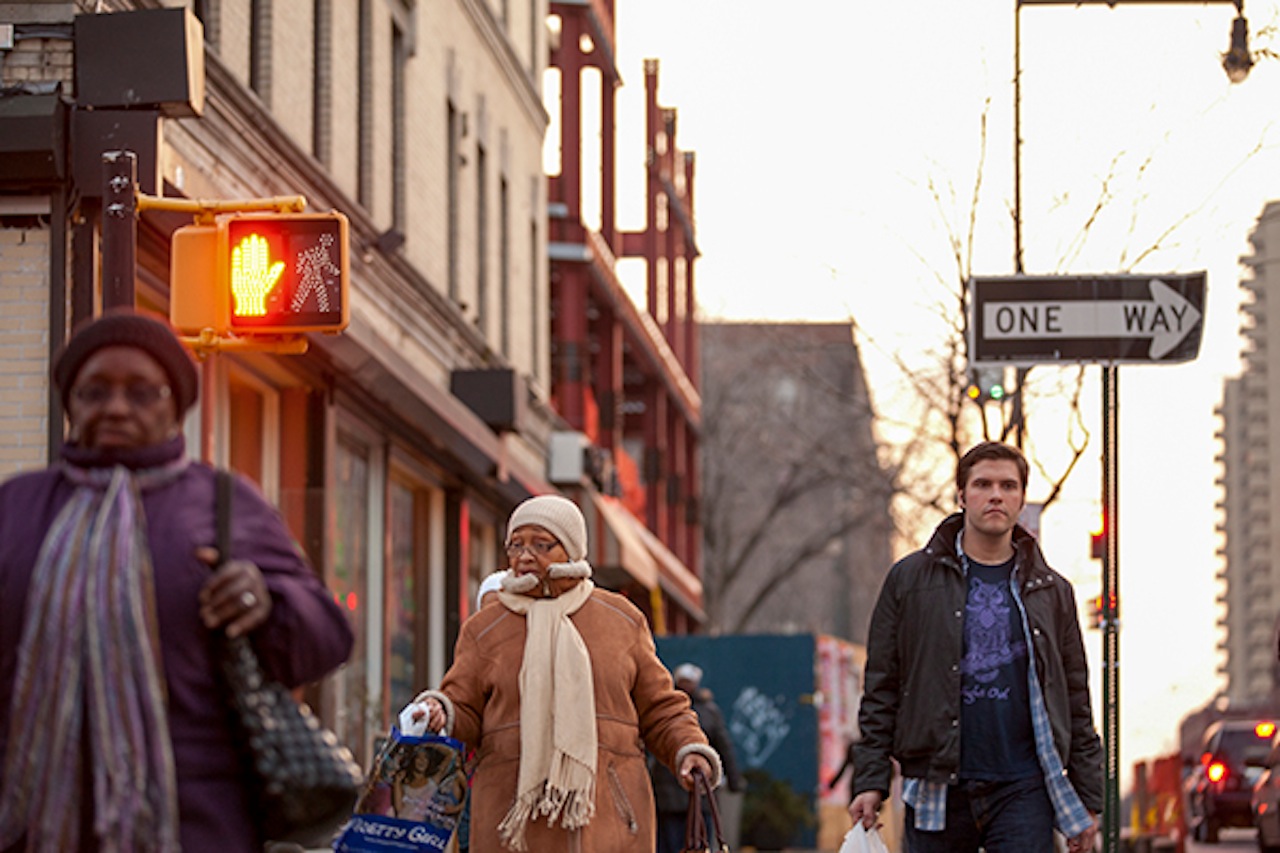
Environmentally speaking, that Franklin Avenue gentrified at all should come as no surprise. The entire avenue runs for about three miles from the Brooklyn Navy Yard to Prospect Lefferts Gardens. The gentrified portion stretches from St. Marks Avenue to Eastern Parkway, and resonates east toward Nostrand Avenue and west toward Grand Army Plaza. It is exceedingly pedestrian-friendly, one of the rare strips in New York where there is more sidewalk than street. Crown Heights itself is rich with a gorgeous brownstone housing stock and lies a short distance from Prospect Park, one of the most popular outdoor spaces in New York City. It’s also served by a bevy of subway lines, providing convenient access to and from Manhattan.
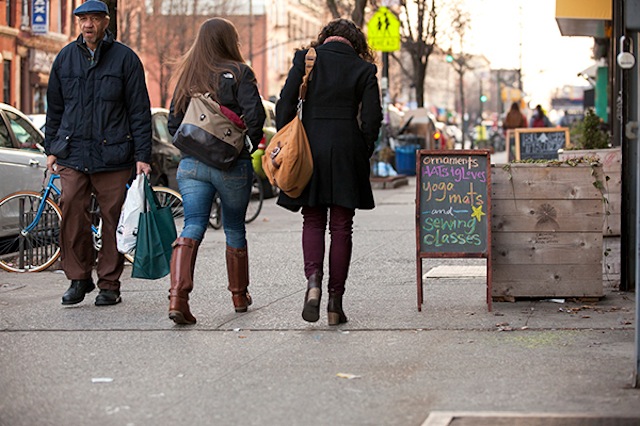
Since 2008, fifty-two new businesses have opened along Franklin Avenue north of Eastern Parkway, with sixteen of them arriving in 2012, according to the popular neighborhood blog, I Love Franklin Avenue. In the same span of time, thirty establishments closed, with eleven going last year.
Today, the avenue bustles with economic and social activity. A strong sense of community reigns, one comprised of a wealth of residents from different generations and walks of life, which is apparent to anyone who takes the time to visit, grab a cup of coffee and watch the world go by for a couple minutes.
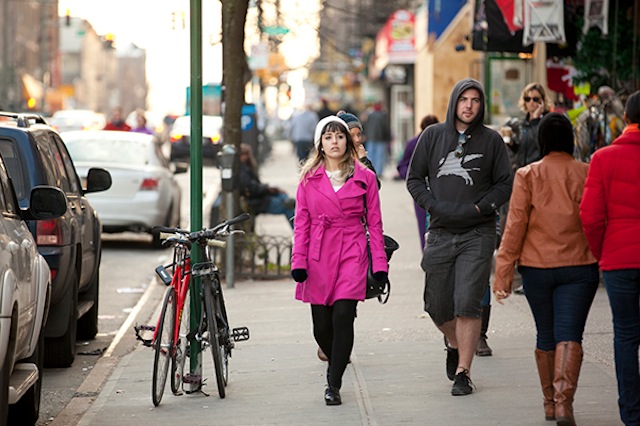
Franklin’s new business owners tend to be well-educated, in their thirties or forties, and proud of letting their personalities speak through their establishments. Many live in the neighborhood.
Michael De Zayas, thirty-eight, bought an apartment just off Franklin Avenue in 2012 and, shortly after, opened a Parisian-style café on Franklin, Little Zelda, named after his sixteen-month old daughter.
“One of the inspirations for me,” says De Zayas, “was that I love to read the newspaper and have a baguette every morning, and you couldn’t do that here before.”
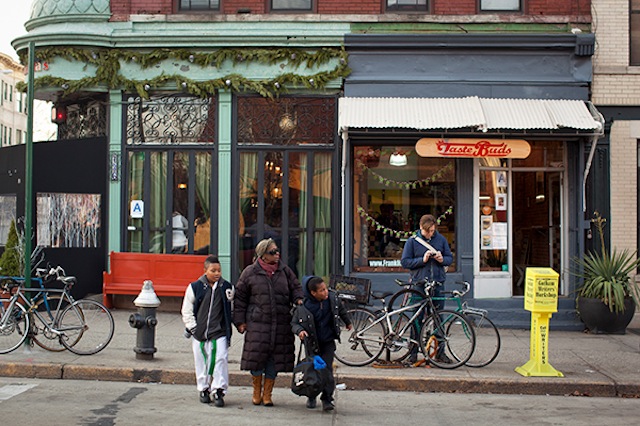
De Zayas, who holds an MFA in poetry from Sarah Lawrence College, is not a career barista. He started out as a travel writer and then created a profitable custom t-shirt and sweatshirt company, which he recently sold. This fall, he also opened It Takes a Village, a non-profit community space for children to play and parents to congregate, across the street from Little Zelda. (He now has plans to relocate to a nearby building.)
Nearly one hundred families have already signed up, paying $35 dollars a month in membership fees. A majority of them are white, but De Zayas, whose father was born in Cuba, says he is working to bring in more families of different ethnicities. He hopes to purchase additional storefronts along Franklin and create other community spaces because, as he puts it, “I don’t want this to become Park Slope.”
“When I went into Park Slope with my stroller, I became invisible,” De Zayas says of his experience as a stay-at-home dad. “That isn’t the case here. People take the time to say ‘hi’ to each other. And a lot of my efforts are aimed at keeping that alive, at keeping the community engaged.”
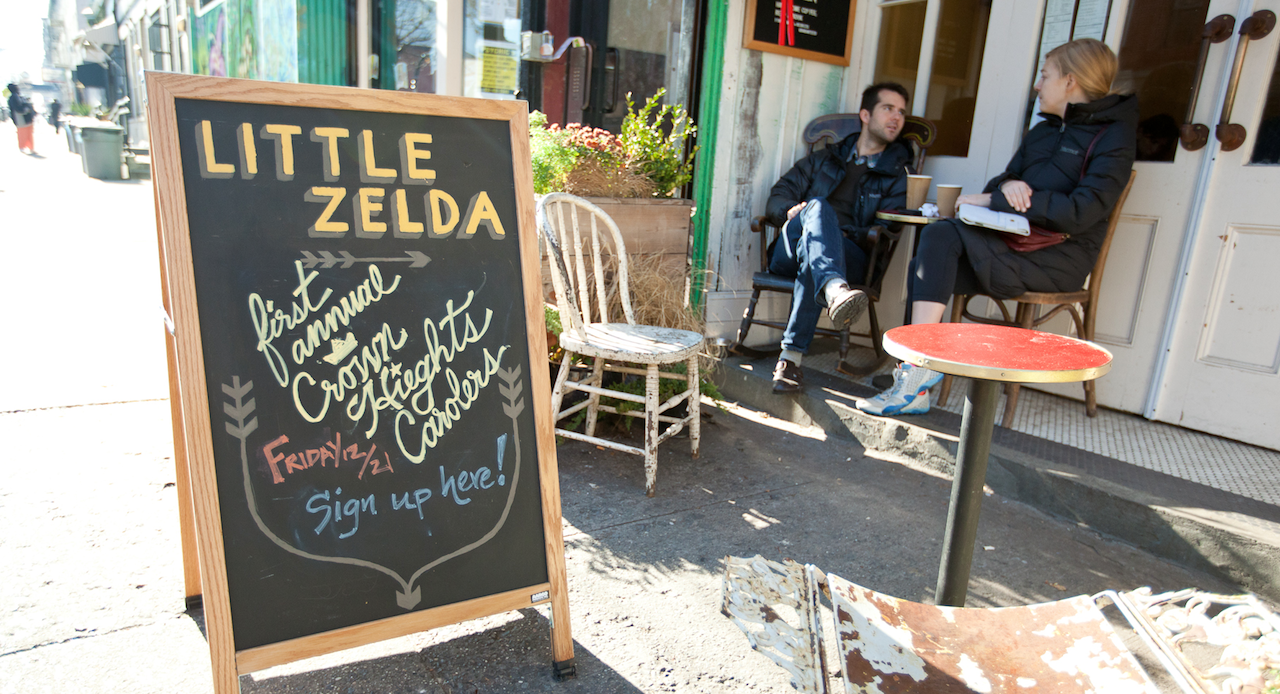
That anyone could worry about Franklin Avenue turning into Park Slope, one of the wealthier, more undeniably gentrified neighborhoods in the entire city, is telling in and of itself. Not long ago, Crown Heights was considered a no-go zone for business.
“You know, two years ago if you told me, ‘Come to Franklin Avenue,’ I would say, ‘You must be crazy,’” says Atim Oton, co-chair of the Economic Development Committee for the local community board.
In 2004, Oton, a forty-three-year-old from Nigeria, left behind a successful career in architecture to found Calabar, a small chain of stores selling middle to high-end African, Asian and South American imports. Oton’s first store was on nearby Washington Avenue. In the spring of 2011, a fire destroyed a chunk of Oton’s merchandise and forced her to close until June. With time on her hands she looked east toward Franklin.
“I had known that this area was changing, but I didn’t quite know what kind of change it was going to be,” she says. “So I came down here and looked around and said, ‘OK, this is a shopping street.”
Oton leased a narrow storefront at 708 Franklin where she pays less than $2,000 a month, a steal compared to a neighborhood like Park Slope where she’d pay as much as $12,000. However, the cost of commercial real estate on Franklin Avenue is rising quickly.
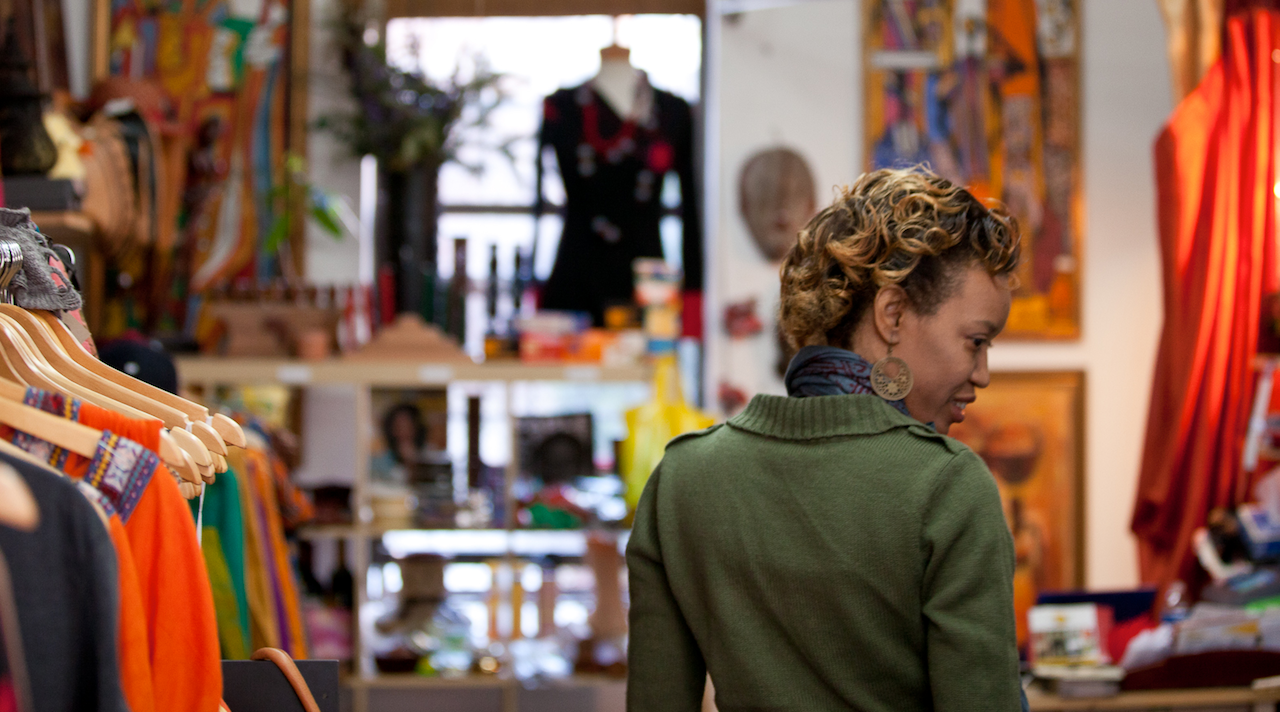
“We signed our lease in March,” said Henry Carter, thirty-one, who opened Excelsior Bike Shop in a former storefront church at 694 Franklin Avenue last year. “A friend who’s a real estate agent basically told me that similar sized places on the block are now going for twenty to twenty-five percent more than what we signed for.”
Business owners say that rising commercial rent has played a roll in pushing out long-standing establishments, and even a few of the newer ones that tried to capitalize on the change.
For instance, Climax, a store selling urban clothing at 775 Franklin, is moving to Fulton Mall in Downtown Brooklyn, a popular shopping destination among minorities, which itself is undergoing a radical redevelopment. Similarly, the Franklin Avenue location of Mazon Discount, a small chain of dollar stores that has been in the neighborhood since the 1990s, has seen business lag, and is now bringing in goods it hopes newer residents will appreciate, like pet supplies.
“We’re not dead yet,” said Abraham, a twenty-seven-year-old employee, who like several people interviewed for this article preferred not to give his full name. But, he conceded, “business is down. Everything started changing.”
* * *
“Gentrification is here,” says Oton, the Calabar shops owner. “This is the avenue that is really dancing around it. We don’t want to talk about it. We’re afraid to have conversations about race and income and class. And that’s an American problem.”
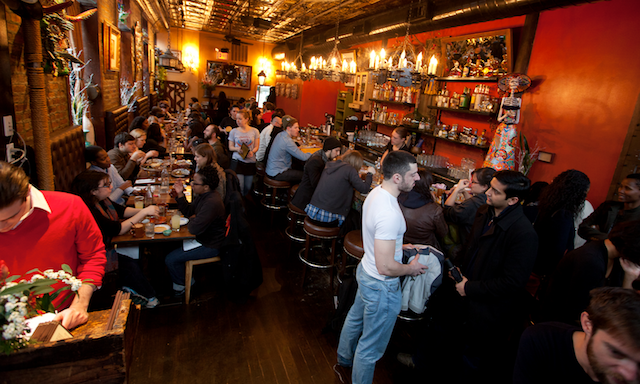
Others are less concerned.
“I actually don’t have many feelings about it,” said one white newcomer, a twenty-eight-year-old woman who bought an apartment in the area last year. “I like my neighborhood because it’s nice and it has fancy coffee, but also because it’s still not totally white, so it’s a little less of a shopping mall.”
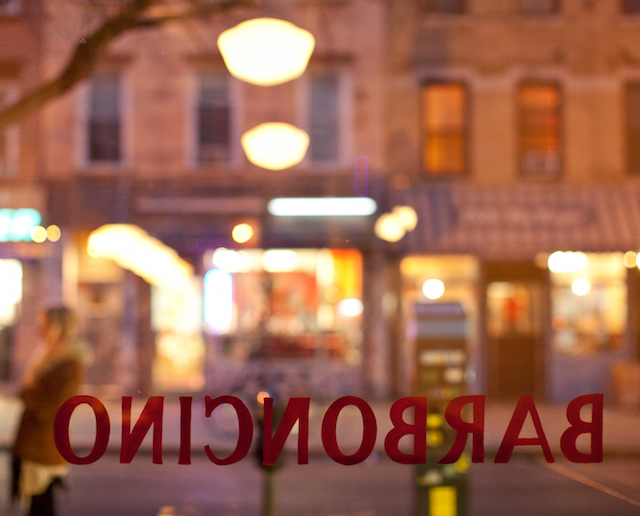
“Though,” she went on, “I’m looking forward to the Section 8 rentals in my building going condo as well,” so that property values will increase.
“But also because owners tend to respect the building more,” she said. “There’s been a shady police presence here, and a shooting next door that is somehow tied to one of the units.”
To be sure, white residents aren’t the only ones untroubled by the change.

“When I came here eight years ago the violence was calming down, but it was still there,” said Kathy, a younger African-American woman who pays $700 a month for a two-bedroom apartment on Franklin. “Now I would say it’s like a Little Manhattan over here. A lot of Caucasian people moved in—a lot. You saw one, then you saw three, then you saw a billion of them. And I think that’s what really changed the neighborhood.”
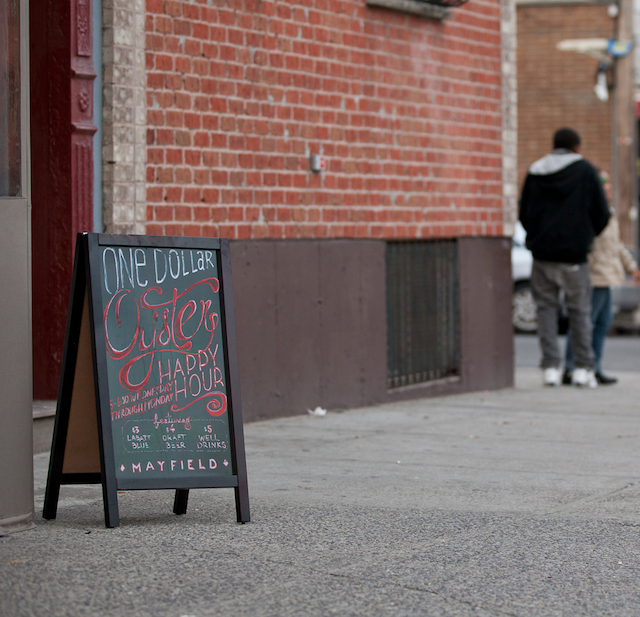
But that doesn’t really bother Kathy. “If it’s for you, it’s for you,” she said with a casual shrug and a drag off a cigarette, before adding that she now shops at the Fulton Mall for cheaper prices.
Meanwhile, many white residents seem torn between embracing the change and lamenting it. As Cory, a thirty-year-old white man who moved to the neighborhood in 2007, put it, “There’s a Haitian restaurant shitbox next door that I’d never dream of going into.”
“Where’s the thing in between that and Barboncino?” he said, referring to a trendy Neapolitan-style pizzeria that opened on Franklin two years ago to the unfettered delight of the foodie community.
“It’s just a little strange,” Cory explained. “You go from four-dollar Chinese food sold from behind bulletproof glass to a twenty-eight dollar pizza and a Lambrusco in half a block. What fills the gap between them?"
He thought for a moment and continued:
“But it’s weird because I really like Barboncino. They do something well. The food is terrific, it’s worth it. I just get the feeling that they were thinking about where the neighborhood was going rather than where it was when they opened.”
Often, these conversations come back to race. Some white women say they used to endure racially tinged catcalls from men in the neighborhood, but not so much any more. Conversely, some long-term black and West Indian residents say they continue to feel cold-shouldered by white newcomers.
“White people pass by here, and they’re talking, but they won’t talk to you,” said Edward, a Trinidadian-born property owner in his sixties who went on to perform a pantomime of a white person passing a black person—suddenly speeding up and averting eye contact.
“Ah come on!” he said, exasperated. “Let me tell you something. I’ve lived here thirty-seven years, and now I start to see white people moving in. And I’m telling you the truth now, I start to feel like…‘But why are all these people moving in? And I think to myself, ‘Ah shit!’ The changes around here’—the police start to change; all this other shit, all these bicycle things, bicycle stands. All these changes the last two or three years, and I say, ‘But why?”
* * *
It would be a mistake to say that the change on Franklin came only from outside.
In the early 2000s, the avenue was still crime-ridden—”a hot, ugly, dirty, drug-infested street,” as once described by Evangeline Porter, the president of the Crow Hill Community Association.
Crow Hill, which was formed in 1984 and began attempting to revitalize Franklin Avenue in ’99, worked diligently to beautify the blocks, planting trees, removing graffiti, and asking homeowners to install gates instead of iron doors. They had no patience for the criminal element in the community or for those who littered and loitered on street corners. As one neighborhood observer put it, “If you look at the people who come to Crow Hill meetings, it’s not the guys who are getting stopped and frisked. It’s property-owning people, often women, often retirees, who’ve been here a long time, and who have very little nostalgia about what the neighborhood used to be.”
It wasn’t long after Crow Hill’s beatification blitz that white people began moving into the neighborhood. By 2008, the white population, though still a minority, had become a noticeable presence. Some got mugged, says resident Mike Fagan, a forty-three-year-old employee at a social service agency who is white and has lived in the neighborhood since 2003.
“There was a period,” Fagan said, “when the neighborhood attracted young, naïve white people who were mugged pretty frequently because they lacked street smarts and they couldn’t perceive risk. They brought an attention,” he added.
That “attention” was further heightened during the summer of 2009, when a string of fatal black-on-black shootings rattled the neighborhood. Concerned residents, local elected officials, and the Crow Hill Community Association (whose members declined requests to be interviewed for this story) made a vigorous, and successful, push to reapply an increased police presence, known in N.Y.P.D.-speak as an “Impact Zone.”
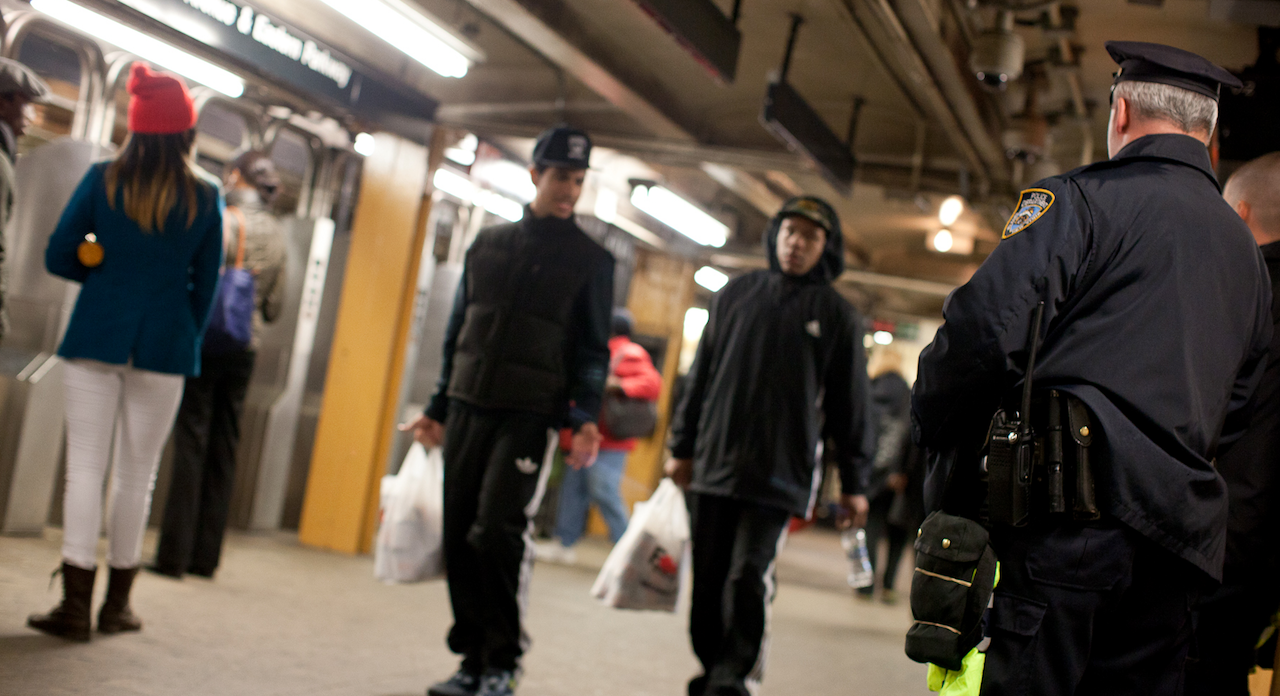
Impact Zones stem from “Broken-Windows” policing, a law enforcement practice that focuses on quality-of-life offenses like public urination, public drinking, graffiti and drug dealing in an effort to curtail the overall culture of street crime. The program was first launched by the NYPD in 2003.
Some in the neighborhood say that Franklin Avenue was targeted from the start. Others believe the Impact Zone has come and gone, and come back again. Nearly everyone interviewed for this story agreed that the community’s reaction to the muggings and shootings of 2009 had a re-energizing effect on it. Police officers became a regular presence on the avenue, standing at street corners and creating an environment in which criminal behavior could not go unnoticed. For some, the surge in cops seemed suspicious, as if it was designed to hasten the change.
“It’s kind of like, ‘Wow, you didn’t come before when we were calling, but now you’re here everyday,” said Craig, a forty-year-old black man who has lived in the neighborhood for seventeen years. “When out here was rough, if you called the police you was lucky if they came at all.”
Other residents reject the notion.
“A real cynic would say it’s about policing the street for development,” said Nick Juravich, a twenty-eight-year-old urban history PhD candidate at Columbia University. “But it’s more complex than that,” added Juravich, a neighborhood resident since 2008, who is white, and the author of the I Love Franklin Avenue blog. “It’s about who can speak to the police and who can navigate the channels of communication.”
Whatever the politics of the Impact Zone, it worked. Street corner drug handoffs and gunplay are now rare occurrences on Franklin Avenue. But many say its tactics have proved antagonistic. Some residents say the police officers bring a “war zone” mentality to their beat.
“These are often young cops who are strangers to the neighborhood,” said Juravich. “It’s an adversarial position.”
For young minority men, law-abiding and non-law-abiding alike, the specter of stop-and-frisk—an intensely controversial NYPD tactic that allows officers to search suspicious individuals for contraband or weapons—became a menace.
Abraham Paulos, a thirty-one-year-old of Eritrean descent who has lived in Crown Heights on and off for seven years, says he had no trouble with police before the Impact Zone came in. But in 2010 he was stopped and frisked twice, and wrongfully arrested once, spending a weekend in Rikers Island jail in the midst of midterm exams at The New School, where he was pursuing a master’s degree in—irony of ironies—human rights.
Paulos, who is now the executive director of Families for Freedom, the nonprofit group that supported him through his court case, first came to the U.S. from Sudan as part of an asylum program for stateless refugees. He still resides here on a Green Card status, so the arrest resulted in a threat of deportation before it was eventually overturned.
“If I was white I would be a gentrifier,” noted Paulos, who said he felt safer in pre-gentrified Crown Heights. “But I’m not, so I’m a threat.”
While no one in the neighborhood denies that the Impact Zone has made the streets safer, some wonder if it has actually stopped crime or merely pushed it away.
Henry Carter, owner of Excelsior Bicycles, likened it to “putting a drop of soap into a petri dish full of dirty water. All the dirt shoots out, but it’s nice and clean in the middle.” (Neither the 77th Precinct nor the NYPD’s press office responded to requests to learn more about the successes or failures of the Impact Zone.)
* * *
“These guys—right here,” Sharon says angrily, standing on Franklin Avenue and pointing up to a banner reading MySpace NYC. “These guys are changing the whole block.”
Sharon is a thirty-nine-year-old black woman, a former construction worker who has lived in the area for twenty-eight years. MySpace NYC is a real estate agency that arrived in 2008, and is perhaps the most controversial, notorious player in the entire Franklin Avenue saga.
By all accounts, MySpace, which is the most visible real estate firm in the neighborhood, does much more business as a brokerage firm working with landlords than it does as a landlord itself. But rumors abound about shell corporations that principals of the company create and then use to purchase property. A undated marketing letter from a group called IDG Holdings but signed by a principal of MySpace informs building owners: “We buy properties ‘As is’ and in any condition and price range. We pay Top Dollar, in Cash, without any Broker fees. We can close as fast as 7-10 days…”
“They try to harass you into selling,” said a West Indian man named Mike, who owns a building just off of Franklin on St. John’s Place. Two years ago, he put his building up for sale, but subsequently withdrew it from the market. He claims that MySpace NYC agents have been hounding him ever since.
“They call you at all kinds of hours,” said Mike. “They’ve come to my house and I have to chase them away…They make offers to you: ‘Oh, we’ve got lots of cash. Let’s do it right now,’ like you’re desperate…Every day the same thing. You tell them no, and no don’t mean nothing!”
The fact that many real estate agencies that do business in the neighborhood happen to be Jewish-owned injects another level of ugly ethnic animosity into the debate. “The Jews” was a phrase that slipped off of many peoples’ tongues in reporting on housing for this story—a kind of shorthand for “real estate” among many blacks and Latinos. (Just a few blocks off of Franklin lies one of the largest communities of Hasidic Jews outside of Israel.)
“I think it’s like the Jewish underground mob going on,” said Sharon. “From what I know of Jewish people, they all stick together…They try to handle their own business.”
But as for the ownership of MySpace NYC specifically, Sharon elaborated: “They’re not regular Jews who wear black. They wear the jeans, the designer labels.”
MySpace NYC refused to respond to multiple interview requests, including visits to its Crown Heights office. Sharon says she knows of instances in which MySpace offered renters buyouts—sometimes $5,000, sometimes $10,000 or more—to leave their apartments.
“My friend Charice,” Sharon said—“her and her mother were the only people I know of who came out on top. Myspace came with a $10,000 offer, and her husband was like ‘You better go back and do your math.’ She told me she got $35,000, her mother got $35,000. They put it together and got a house in Queens.”
Sharon’s friend Raquel Cruz had a harder time of it. Cruz is fifty-one and of Puerto Rican descent, a gregarious mother of five who still cares for a thirty-four-year-old daughter who suffered brain damaged at birth. She and her husband are diabetic. She works as a maid and also does odd jobs—cleaning, shoveling, painting, can collecting—anything to get by. “I’m a street hustler,” she says, “but a good one, you understand?”
In 2008, after having been bought out of an apartment in Brownsville and twice accused of owing $10,000 in back rent from a landlord on Franklin Avenue, Cruz moved with her husband and daughter into a six-unit apartment building at 724 Franklin, where the tenancy was mostly Dominican and the landlord was black.
The situation at 724 Franklin was a mess, said Cruz. The Dominican residents paid a mere $500 a month in rent, far under market value, when they paid at all.
“They had been there for forty and fifty years,” she said. “I was the only one who paid my rent.” According to Cruz, the landlord, with whom she sympathized, didn’t take non-paying tenants to court because “he didn’t have the money for the lawyer.”
The hallways were filthy, strewn with trash bags that attracted mice and rats. In the winter months, the landlord struggled to keep the units heated. “He couldn’t pay for the oil because no one paid rent,” Cruz recalled.
In early 2010, overwhelmed by violations, the landlord sold the building and fliers went up in the hallways informing the tenants of where rent was now to be paid: 722 Franklin Avenue, the address of MySpace NYC, which had approached the landlord with the purchasing offer, Cruz says.
“They didn’t say, ‘You have to leave,’” she said, “but I knew that was their purpose, because I’d already been evicted by the Jews. I knew what they’re capable of doing.”
Across the street, Michael Kunitzky first caught wind of the sale when the owner of a deli he used to frequent in Cruz’s building told him he was packing up and moving to Florida. The deli has since turned into the Crown Inn, a popular neighborhood bar serving classic cocktails and pork belly sandwiches.
Kunitzky is thirty-seven years old and white. He moved into the neighborhood in 2005, and, soon after, opened LaunchPad, a free “community gathering place” that hosts screenwriting workshops and storytelling nights, and shares a space with It Takes a Village, directly across from Cruz’s old apartment.
The news of the deli’s closing piqued Kunitzky’s interest. “That was the first rumor,” he said. “A few months later they started getting people out of there.”
“It all happened so quick,” remembered Cruz, who had previously met Kunitzky at community events. “They relocated everybody.”
Most of the Dominican tenants had passed their apartments down from relative to relative and lacked leases, Cruz notes, so they were in no position to negotiate with MySpace NYC agents, whom Cruz says offered meager buyouts. “One went to Brownsville,” she said. “Another to Lincoln and Classon, another went to Union Ave.”
Concerned but unsure of what was happening, Kunitzky casually broached the subject with Guy Hochman, one of MySpace’s owners. “I don’t think he fully understood my feelings,” said Kunitzky. “He was complaining to me about the buyout payments. ‘Oh, you know, we’ve got to pay these people off, and it’s a pain in the ass.’ And I kind of gave him this strange look, like, ‘You’re crying to the wrong person, my sympathies don’t lie with you.’”
Cruz says she was offered $10,000 and three months paid rent at a two-bedroom apartment “with a little skinny kitchen” on Quincy Street in Bedford-Stuyvesant, with a rent of $1,300 a month, $400 more than she was paying on Franklin Avenue. MySpace also offered to pay for her moving costs and provide her with a permanent cleaning job. Cruz admits that MySpace also had done “nice things” for her in the past, such as offering her one-off cleaning gigs. “But they were nice to me because they had to be,” she says. “If they had treated me bad they wouldn’t have been able to get me out. They had to play me.”
She knew that she would struggle to afford the $1,300 a month rent, but she says she felt compelled to sign, pressured by the money and the fact that her neighbors were vacating.
“My husband said, ‘We’re not leaving,’” Cruz remembers. “He said, ‘Don’t go behind my back signing no papers.’ I said, ‘No, I’m not going to do it.” And boom! I went and signed the papers behind his back.”
By this point, Kunitzky had confirmed his suspicions and confronted MySpace’s ownership in their office. “They made mention again that there were people in the building who were willing to take payments,” said Kunitzky. “I told them, ‘You’re taking advantage of people who don’t understand the economics of what’s happening,’ which was not very well received.”
“The day that it really escalated,” however, “was when Raquel was getting forced out,” he said of Cruz.
It was late one spring morning in 2010 and there was a commotion in the street. Cruz and her husband were ordering moving men to bring all of their furniture, which had been brought onto Franklin Avenue, back into their apartment.
“I had a deadline to move out,” Cruz said, “and I went over, something like a couple hours. And then they were telling me that they weren’t going to give me my money!”
“That’s when I ran and got Mike.”
When Cruz showed Kunitzky her contract, he became enraged. “That was the last piece I needed to see,” he said. “Her contract stated that she had to be out by, like, noon, and it was about 1 PM, so they were trying not to pay her. I went over there and just said to them, ‘Look, she’s not fucking going anywhere.’”
Kunitzky threatened to take legal action. He says he was then confronted by a MySpace employee, “an ex-Marine,” and by a man believed to be a MySpace owner. Punches were almost thrown.
“Everybody wanted to hit somebody,” Cruz recalls. “Chaos.”
Eventually, things calmed down and Cruz was assured she would get her money. Kunitzky took her aside to talk.
“Look,” he remembers saying, “this is completely up to you. You don’t want to take the money? You don’t want to leave? Rip up this contract right now.”
But Cruz did want the money, and she did end up leaving, a decision she now realizes she didn’t have to make.
“They played me, they played me,” she says.
Soon after Cruz left, the last holdout gave in and the building flipped completely. The property was renovated and the new residents, as Kunizky puts it, “appear to be in a much different socio-economic class than the previous tenants.”
Jonathan Boe, a former MySpace broker told a City Limits reporter in June 2011 that although he wasn’t directly involved with 724 Franklin, the renovation scenario, to paraphrase the reporter, “sounds familiar.”
“They love gentrification,” Boe was quoted as saying. “It’s getting tenants who are willing to pay higher rent.”
Cruz’s own higher rent at her new apartment nearly drove her into financial ruin. She never got the permanent job MySpace had promised her, she said, and she began pawning her belongings to stay afloat. Then, one day, she recalls, “one of the beautiful parts of the story” of her life took place.
About four months after moving, she was walking past her old apartment on Franklin Avenue on the way to a cleaning gig.
“My husband is always asking me ‘Why do you always look down at the ground?’” she says. “I tell him, ‘Because I have found nice things on the ground. I’ve found nice earrings. One time I found a one hundred dollar bill.’” On this particular day, Cruz found a letter that was addressed to her, covered in footprints. It was from the New York City Housing Authority. When she opened it she learned she had been granted public disability housing, which she had applied for years earlier.
“I was screaming,” Cruz said. “I was jumping for joy.”
The housing authority had been trying to reach her for weeks, Cruz says, sending letters to her old address. She had only one day left to respond before losing the spot in the Albany Houses, a public housing project a mile east of Franklin Avenue, deeper into Crown Heights.
“That’s where I am today,” Cruz said.
She only pays $82 a month in rent.
* * *
It is important to dispel the myth that gentrification is a natural process, says twenty-two-year-old Crown Heights resident Nick Petrie, “because it so conveniently leaves out very important actors in the process.” Petrie, a community organizer who has lived in the neighborhood since September, is working in his free time to bring awareness to some of these actors—those who push gentrification for profit—through a group he helps administer called the Crown Heights Assembly. The year-old Occupy-inspired organization has a goal of bringing new and longtime residents together to organize against what they see as predatory housing practices. Specifically, the assembly is focused on exposing what they consider to be collusion between deadbeat landlords and real estate companies that do business with them, like MySpace NYC.
Between fifteen and fifty community members generally attend the group’s monthly meetings, and about two hundred people are on their email list, reports another organizer, Ryan Richardson. In November 2012, the assemby staged a small protest outside MySpace’s Franklin Avenue office, demanding the company provide prospective tenants a legal rent history and compel landlords to stop displacing residents.
At a recent Crown Heights Assembly meeting, Petrie sat beside his upstairs neighbor, Sonja Bent, fifty-two. Both live in an apartment building at 577 St. Johns Place. Petrie pays $1,800. Bent pays $1,033 for the same amount of space.
Petrie, who is white, says he found the apartment through Craigslist. “The first time I learned it was MySpace” representing it, he said, “was when the logos were on the papers.”
Within the first month of living in the apartment, Petrie had dealt with rats in the walls, spotty heating and a ceiling that had collapsed four times, due to a water leak in the apartment above his—Sonja Bent’s.
Bent, who has lived in the apartment for eighteen years, is one of three remaining long-term residents who have refused to give in to the pressures to leave by the building’s landlord, Elcorno Martin, whose 142 reported housing violations rank him among Brooklyn’s “50 Worst Landlords,” according to city Public Advocate Bill de Blasio.
Petrie says he had no idea of the battles he would face from Martin in trying to get repairs.
“He effectively could take the place of a cartoon villain,” says Petrie. “Where some people might say, ‘Oh, okay, I’ll fix it,’ and they never do, he just yells at you.” Petrie says his apartment’s neglect is connected, literally, to Bent’s. It was leaking pipes in Bent’s apartment that caused Petrie’s ceiling to collapse. Bent, for her part, says she has requested repairs for years, and filed numerous complaints with the housing authority, none of which have led to any improvement.
Leaky pipes, though, are just one item on the docket of repairs-to-be-done in Bent’s apartment. The front door, which looks like it has not been painted in decades, is attached by one hinge. In the kitchen, a large hole in the wall under the sink goes straight through to the bathroom, which provides rats and even raccoons with easy access to the apartment. (Bent once battled off a raccoon inside of her apartment. “They come up from the basement,” says her daughter, Harmony, sixteen.)
<
The bathroom ceiling is dotted with black mold. A long, thin crack runs through the living room wall. The master bedroom is lit by freestanding lamps because the overhead light fixture has been broken for years. The dim lights are just bright enough to illuminate large water stains in the bedroom.
Bent takes this all as a not-so-subtle message from Martin to get out. But she is determined to stay, she says, not because she loves the building or the neighborhood, but because she wants to teach her children, by example, to stand up for themselves.
“I have four children at home with me, two out of the home, and if I leave now, what am I teaching them—just walk away?” Bent explained. “I have to teach them that just because the odds are stacked up against you doesn’t give you an excuse to walk away. I have to teach them to stand up and fight for themselves.”
* * *
The Crown Heights Assembly believes, in the words of Richardson, the organizer, that “none of this stuff is inevitable.” Local businessman Kevin Phillip, who has no involvement with the assembly, would agree—to a point.
Phillip, forty-one, was born in Trinidad and owns two successful businesses on Franklin—vintage-themed sweets shop Candy Rush and a sandwich spot called Taste Buds. He is well known and well liked in the neighborhood.
“The only person I can say who’s really helping fight for the neighborhood is Kevin,” said Sharon, the longtime resident and MySpace NYC hater.
Phillip is also one of the few pre-gentrification business owners who saw the change coming and capitalized on it. An electrician by trade, he owns four trademarks as well as a building on Franklin Avenue, which he bought eleven years ago and has run multiple businesses out of.
“In a neighborhood that’s changing like this one, you have to be quick on your feet,” he said.
On the question of change he is, by all accounts, a realist.
“Reality is, if building owners sit down with Real Estate, and Real Estate says, ‘Look, I’ve got all these people looking for apartments, and you have what I need,’ it’s Business 101, basic math,” Phillip says.
In discussing the wave of economic interest that has swept over Franklin Avenue with people like Phillip, an attitudinal divide begins to emerge. Some think it doesn’t have to be so cutthroat and profit-driven; others say, “Maybe it doesn’t, but it is, so get smart.”
Of the impression that exists among some blacks and Latinos that “the Jews” are out to get them, Phillip, whose business partner is Jewish, shakes his head: “They want to make it like that. But it’s the wrong idea,” he says. “It’s totally the wrong idea…No one’s out to get anyone. They’re out to get their money. That’s what they’re out to get. This is America. America was built like that.”
Similarly, Phillip says of buyouts: “If you’re taking one, it’s like going for fool’s gold.”
* * *
What would it look like, then, what would it take, for a street like Franklin to transition from impoverished and crime-ridden to safe and enjoyable in a way that doesn’t wash out those in the lower economic brackets?
“I think it would take an enormous amount of work and action at many different levels,” says Juravich, the urban history doctoral candidate. “It would take concerted legal action. It would take political action. It would take public consciousness. It would take outreach.”
“But it happens every now and then," he says. “Or it could happen.”
Michael DeZayas, who’s working to ensure the neighborhood doesn’t “turn into Park Slope,” agrees that it’s possible. Others are less sanguine.
“Everything is going to become another Park Slope because that’s the way that this works,” said one neighborhood observer.
Another, a thirty-year-old white woman named Mindy who moved to the neighborhood in 2006, recalled an incident last summer when she was approached in front of her apartment by a white guy in his thirties. “His whole presence screamed yuppie,” Mindy remembers, “and he said, ‘Excuse me, Miss, did you hear the loud music playing last night?’
“I said, ‘Of course. Is this your first summer here? It happens every Saturday night. It’s no big deal once you get used to it. Just part of the neighborhood flavor.’
“And then he was like, ‘Hey, I’ve got a young baby. I can’t be having her kept awake all night. It’s unacceptable and the police need to shut it down.’
“I just wished him luck,” Mindy said, dismissively.
The neighbor may not need it. In April, a group of investors led by Jonathan Butler, founder of the popular real estate blog Brownstoner as well as the artisanal Brooklyn Flea market, and including the Goldman Sachs Urban Investment Group, purchased the former Studebaker service station at 1000 Dean Street, just off of Franklin Avenue, for $11 million. They plan on turning the building into a mix of commercial and creative spaces that should be completed in the summer of 2013, and will likely receive another $20 million in investment–a level never before seen in Crown Heights.
“Until now, we’ve seen maybe local and borough-wide entrepreneurs,” said Juravich. “But when you have Goldman investing, those kinds of folks have different imperatives, they have different kinds of connections.”
Around the time of the 1000 Dean purchase, a Long Island group bought an empty lot at the corner of Franklin and Eastern Parkway for over eight million dollars. Sixty-three luxury condos and more then eight thousand square feet of street-level retail are in the works.
“These are not differences in degree,” Juravich said. “These are differences in kind.”
With luxury development of that scale already rising, even the most die-hard community activists admit this stretch of Crown Heights may not have a place for low-income residents much longer.
“It took a bit of wind out of my sails, watching what happened in this neighborhood, watching how it happened,” said Kunitzky, the resident who tangled with MySpace. “I don’t know how to beat this. I don’t know how anyone can beat this machine.”
“I can see the flip side of it,” he went on. “Everyone likes to say, ‘But the neighborhood is so much safer now. And it’s so much nicer for everyone. And there’s such a better quality of life here now.’ And that’s undeniable.
“But I still think there’s a better and more ethical way to get from a broken down, crime-ridden, drug-ridden neighborhood to a place that is safe and enjoyable for everyone while still maintaining a sense of community ownership.”
Others accept what has happened to Franklin Avenue as just another cold reality, one that plays out through each borough of this city, and others, time and time again.
“Given how wealth and income and education are currently distributed, very few neighborhoods stay diverse for very long,” said Fagan, the social service worker. “So the edge of gentrification will be mixed, but as time goes on, it won’t be.”
“It’s a blurry line,” Fagan concluded. “And we lived in the blur.”
* * *
Like this story? Check out our Most Popular content and sign up for our weekly email updatefor Narratively's latest stories and events.
Vinnie Rotondaro is a contributing editor at Narratively. He lives and writes in Brooklyn.
Maura Ewing is a Brooklyn-based writer, and a student at The New School for Social Research where she is pursuing an MA in Liberal Studies. You can read more of her work here.
Mo Scarpelli is a Brooklyn-based filmmaker and multimedia journalist. She likes hanging out with people until they forget she’s there, and filming or photographing the whole damn thing. Her work has appeared on the BBC, The Wall Street Journal, Africa Review and The Huffington Post. Follow her on Twitter @moscarpelli.
General Document Comments 0








0 archived comments